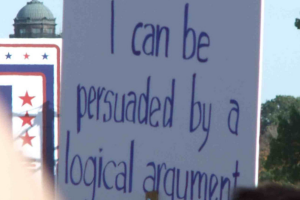Here’s how financial brands can use reception marketing to build trust and equity by meeting consumers’ needs with helpful, relevant content.
Brands are accustomed to pointing their marketing megaphone at the audience and controlling the conversation even in the digital age. Now, it’s the consumer wielding the megaphone and their message is loud and clear: Stop interrupting and start listening.
Consumer behavior tells you what information they’re looking for. The brands that pay attention and address those needs will build long-term trust. This is especially true in the finance industry, where establishing trust with genuinely helpful content is crucial in today’s competitive market.
Consumer trust in financial institutions has fallen nearly 30% since 2021. It’s essential to give consumers the confidence that you are the best steward of their hard-earned financial assets. This requires making an authentic connection and nurturing that relationship long before they make a purchase decision. Financial brands that can capture this upstream communication with the audience will enjoy brand affinity, loyalty and repeat business.
Use data to get the most bang for your buck
Consumers research different financial options at many different points in their journey. When they are looking for answers to an immediate question, they’re opening the door for you to become a long-term source of trusted information. Being that source is key to success,, because consumers prefer brands that provide helpful and timely content.
The good news is that between first and third-party sources you have access to the data for creating trust-building content. For example, organic search research tools can identify the most common search terms for financial services. Reviewing top queries, including questions and long-tail searches, will reveal concerns like: “How much mortgage can I afford?” or “What do you need to open a bank account?”
You can also use your owned asset data and social metrics to implement feedback mechanisms on your website. Direct responses from consumers about their priorities and concerns provide additional insight into the content they seek.
A marketing approach you can bank on
This proactive method, known as reception marketing, uses available data to understand consumers better and meet them in their moment of need. In other words, matching the consumers’ frequency in terms of both content and timing.
This means leaving behind antiquated approaches like siloed interruption marketing (annoying and self-serving) and disconnected permission marketing (which can feel more transactional than supportive).
Reception marketing powers the strategy behind WalletHub and Bankrate. These publishers have overtaken traditional financial brands in search visibility and market share. How? By becoming trusted sources of authoritative, helpful content.
Is your brand ready to step up and be the first to provide the answers consumers are looking for?
What is OAO, and how does it help financial brands?
Owned asset optimization (OAO) is a strategy that can scale your ability to shift into this role of financial guide.
In OAO, you deliver consistent value to consumers through your network of assets, starting with owned media such as your website. Then, you fan out and prioritize other types of assets based on degree of control or business priority. Understanding what drives consumer behavior at different points in their journey — and that they’re steering the ship — will let you create the relevant content they want.
Mapping the customer journey on your website allows you to identify where to build or improve resources, like comparison or calculation tools. Real-time assistance tools like chatbots provide instant support, answering immediate queries and guiding them in their journey.
The key word is “relevant.” Your visitors don’t care about everything you can do; they only care about what they want to do. Tailoring information to match the intent of their queries lets you find the best path to long-term brand loyalty and eventual conversion.
Turning your brand into a trusted publisher may seem like an impossible goal. It’s not. You have industry knowledge, customer data and many platforms. Now you need to direct your marketing efforts toward consumer education.
Optimize and open more eyes
Beyond following SEO best practices so consumers can find and access your content, you need to provide the best possible user experience. Doing this requires regularly analyzing user behavior and adapting strategies based on where audiences spend time with your brand.
This data, along with consumer feedback, will ensure you are providing relevant content that is easy to navigate and understand. Following UX best practices will also help keep users in your brand’s ecosystem through the rest of their purchase journey.
Real-world examples
Let’s say your brand’s consumers are seeking help on topics like “how many credit cards you should have” and “credit card vs. debit card.” They would likely respond well to content that provides an introduction to credit cards. You’ve anticipated their deeper need and proactively filled it.
This means consumers are positively introduced to your brand and are likely to continue their journey using your other relevant resources.
To continue connecting with users, you could provide an article directly related to these specific questions or develop resource guides for common financial situations. You could even build a tool that compares the requirements, benefits and fees of different cards.
These owned pieces of useful, consumer-relevant content can then be utilized in channels where you have less control but give higher visibility: Social media, PR, ads and news. This expands your footprint while driving consistency in how your brand is portrayed.
Don’t be afraid to imitate what successful companies are doing. For example, the publishers who rank well for the query “credit card vs. debit card” have pages offering several different resources for users. They provide in-depth, authoritative articles that help consumers understand card differences and augment them with infographics, comparison charts and financial education guides. Pages like these have helped contribute to massive site-wide traffic for publishers, including recognition from major news outlets.
This is just one example of how brands can successfully meet consumer needs to build more meaningful connections and establish wider brand visibility.
OAO in action: A 265% increase in financial services search market share
This doesn’t just work for content hubs; it also works for financial brands themselves.
A Fortune 500 mortgage lender saw significant growth within one year of implementing its OAO strategy. They reaped the rewards of a custom OAO strategy, which included:
- Conducting audience research: Taking the time to understand consumer habits, needs and wants at every point in their mortgage buying journey.
- Establishing an informational content hub: Building an easily searchable, in-depth library of content to answer consumers’ wide-ranging questions.
- Building comparison tools and guides: Differentiating with intuitive, problem-solving aids that competitors weren’t offering.
This worked to expand the brand’s visibility and performance amongst competitors and drove real business value, improving marketing ROI by 12x and organic traffic value by over 4x.
Understanding the value of reception marketing and creating an OAO plan allows your brand to capitalize on an important opportunity: To stop interrupting the financial consumer’s journey and make their road easier to travel.
Providing the resources they need — even before they realize they need them — positions your brand as a trusted guide so you can foster authentic connections that translate into sustainable, long-term success.
The post Owned asset optimization: The key to connecting with financial consumers appeared first on MarTech.
MarTech(12)






